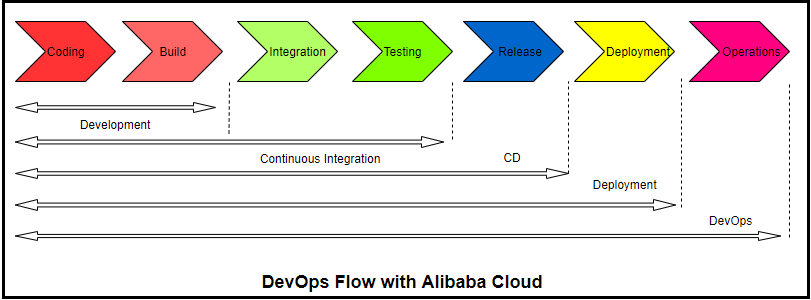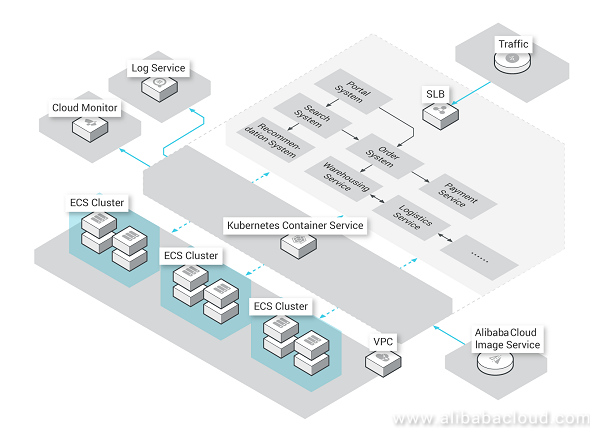By Shantanu Kaushik
Successful implementation of DevOps requires time and management of resources. We have already established that automation is the key and it must be just right. In general, tracking different resources and their usage gives a fair idea of how efficient your system is, and to an extent, that much is enough. DevOps has evolved to be the answer to the most crucial problems an organization may face. In critical situations, one factor that can prove to be vital is choosing your cloud provider.
Alibaba Cloud is an ecosystem of tools and resources that have evolved over time and become the front runner in the cloud stream. When it comes to DevOps, solutions and services like the Elastic Compute Service (ECS) and the Simple Application Server, provides users with an ability to start making and hosting applications.
As your organization grows, you also get the support and back-end resources of the IAC platform and services like Terraform. DevOps has brought such a channeled approach to development and operations with Alibaba Cloud that when we deploy with Kubernetes on Alibaba Cloud, a certain sense of reliability and scalability is guaranteed. With most streamlined Continuous Integration and Delivery practices, your production to delivery time is shortened.
What would make your DevOps implantation the most efficient? Recording the most important metrics in your DevOps cycle will help with efficiency. You need to know what the DevOps challenge is for your organization. You can't have a solution until you know the problem.
A successful DevOps implementation requires velocity, QA, and performance. You need to release the correct deployment size and the correct release frequency to maintain the quality of your application. Maintaining these will get to you where you wish to be in your SDLC with DevOps.

All developer teams want to release as fast as possible with high release frequency. This will highly depend on what kind of code you are writing and how much risk tolerance you have standardized as a part of your DevOps cycle. Here, the most important metrics to be monitored should be around the QA.
Bigger is not always better. Falling short and not meeting customer satisfaction is also something you would want to avoid. It's all about how to implement your DevOps. The first thing you would want to keep in check is how many modules you are working on and how much work these would need in terms of the development perspective. Revisiting the same code multiple times is something no team wants. When you are working with continuous integration and delivery, you need to keep a close check on your deployment size. That has to be in limits and coordination with your team capacity and size.
Maintain a deployment frequency that doesn't interfere with team collaboration efforts. If you are running your containerized application through automated testing, there is a good chance that errors and frequency of failure will be less when compared to manual testing practice. Most of the teams that work around the clock to achieve productivity go through segmented phases that directly affect DevOps efficiency. To curb this, you need to maintain a deployment frequency that makes sure that all teams can keep up with it. During pre-production and production, you need to maintain the QA to make sure that you are no putting out post-release fires regularly.
You need to make sure that you deploy as early and as frequently when deploying to QA. This will ensure adequate time for testing and re-referring.
The time taken for complete deployment from start to finish is a metric one must follow. If an application is taking too much time to deploy, it might affect the overall performance and raise an issue that reflects on a bigger problem with your code. If all of your back-end server resources are up for grabs, your code is working fine in pre-production, but your module takes a longer time to deploy, this points to a bigger problem.
Making certain that you are using the proper architecture and resources is a must. Deploy using Kubernetes and use products like the API Gateway and Resource and Identity Management Service (RAM) by Alibaba Cloud. Checking all the checkboxes for quality and performance is the only thing that can cut down on the time to deploy.
This is one of the most important metrics, as the time taken here reflects on the health of your deployment when compared to other containers of the same application.
Below is the working model of Kubernetes with Alibaba Cloud:

I have already written an article about defect escape rate, which you check out to learn more about this metric.
One noteworthy thing here is to make sure that you record the rate of errors that you receive. It could be the issues during production and the bugs post-deployment. These errors (and the rate at which you receive them) could indicate a major quality issue with your build. With a bug-infested build, you will be challenged with an application outage or traffic fluctuations that can be monitored using the Cloud Monitor. You can also check the server load balancer logs to know if an application is asking for more resources than normal. This often leads to a perfect debug scenario and error pointing.
We will discuss more metrics in Part 2 of this series. The most important bit to take away from this article is that Velocity, Quality, and Performance are the virtues of DevOps. If you can maintain these, your DevOps model is evolving at the correct pace.
You need to deploy with the correct tools and implant with the best in class support from your resource provider. Use Infrastructure as Code (IAC) and make sure that your containerized application is not running out of provisioned resources with Alibaba Cloud ECS.
There are many factors to evenly spread your attention to. Keeping such factors in check should be the main motive behind every step and change you make to your DevOps practice.
The views expressed herein are for reference only and don't necessarily represent the official views of Alibaba Cloud.

2,599 posts | 769 followers
FollowAlibaba Clouder - September 18, 2020
Alibaba Clouder - September 18, 2020
Alibaba Clouder - December 25, 2020
Alibaba Clouder - October 28, 2020
Alibaba Clouder - March 29, 2021
Alibaba Clouder - September 2, 2020

2,599 posts | 769 followers
Follow Container Service for Kubernetes
Container Service for Kubernetes
Alibaba Cloud Container Service for Kubernetes is a fully managed cloud container management service that supports native Kubernetes and integrates with other Alibaba Cloud products.
Learn More ACK One
ACK One
Provides a control plane to allow users to manage Kubernetes clusters that run based on different infrastructure resources
Learn More Cloud-Native Applications Management Solution
Cloud-Native Applications Management Solution
Accelerate and secure the development, deployment, and management of containerized applications cost-effectively.
Learn More DevOps Solution
DevOps Solution
Accelerate software development and delivery by integrating DevOps with the cloud
Learn MoreMore Posts by Alibaba Clouder